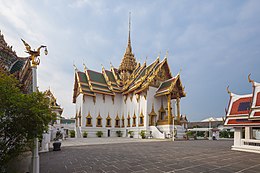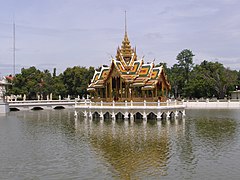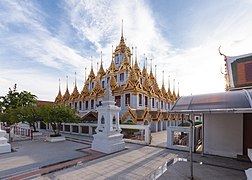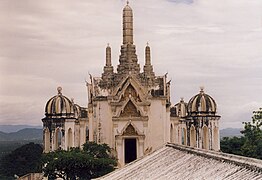
A prasat ( Thai: ปราสาท, from Sanskrit: prāsāda), or more accurately, kudakhan (กุฎาคาร, from Pali/Sanskrit: kūṭāgāra) or rueanyot (เรือนยอด), is a Thai architectural form reserved for royal palaces of the monarch or for sacred religious structures. It is a building featuring an ornate roof structure, usually multi-tiered, with one or more spires. The form symbolizes the centre of the universe, which is traditionally associated with the monarch or the Buddha. [1] [2] Prasat forms are widely used in the buildings of the Grand Palace, and are also found in some Buddhist temples ( wat) and in the architecture of the temporary crematoria used for royal funerals.
Architectural historians have classified kudakhan into several categories, according to the shape of the spire: mondop-shaped, prang-shaped, mongkut-shaped, and others (including stupa-shaped and phra kiao–shaped, depending on the author). [2] [3]
Gallery
Mondop-shaped
-
Sutthaisawan Prasat Throne Hall, Grand Palace
-
Aphon Phimok Prasat Pavilion, Grand Palace
-
Rueanyot Borom Mangkhalanusorani, Dusit Palace
-
Aisawan Thipphaya-at Pavilion, Bang Pa-in Palace
-
Royal crematorium of Princess Bejaratana
-
Loha Prasat, Wat Ratchanatdaram
Prang-shaped
-
Wetchayan Wichian Prasat Throne Hall, Phra Nakhon Khiri
-
Prasat Phra Thep Bidon, Wat Phra Kaew
Mongkut-shaped
-
Wihan Yot, Wat Phra Kaew
-
Phra Mondop, Wat Pho
See also
- Pyatthat – Burmese equivalent
References
- ^ Royal Society. พจนานุกรมฉบับราชบัณฑิตยสถาน [ Royal Institute Dictionary] (in Thai).
- ^ a b Pastraporn Keanprom (2014). "รูปแบบพระปรางค์และสถาปัตยกรรมที่มียอดปรางค์ในรัชกาลที่ 4–6" [Architectural Style of phra prangs and steeple prangs during the Reign of King Rama IV-VI]. NAJUA: History of Architecture and Thai Architecture (in Thai). 11: 226–253. ISSN 2697-3901. Retrieved 28 January 2020.
- ^ Athit Limmun (2005). การศึกษากุฎาคารในสมัยรัตนโกสินทร์ [A study on kudakhan in the Rattanakosin period] (PDF) (Master's thesis) (in Thai). Chulalongkorn University. ISBN 974-53-2626-7.










